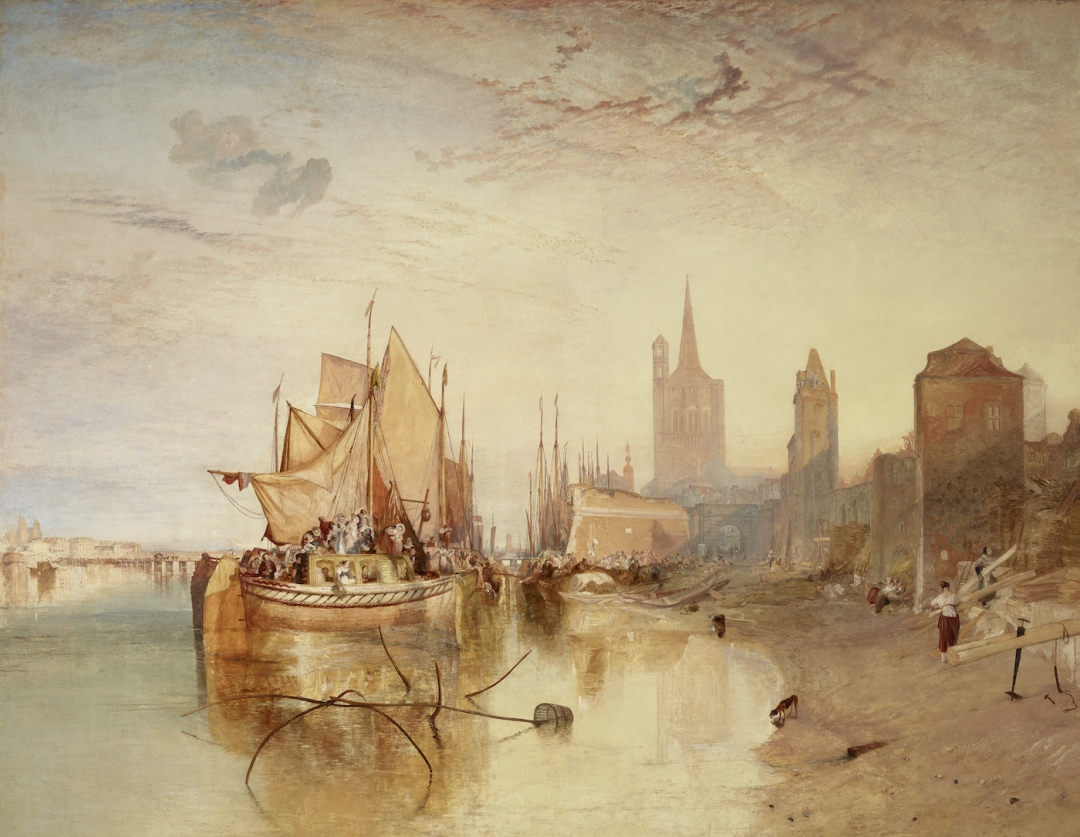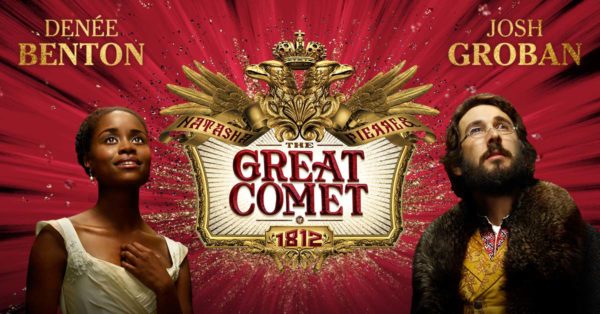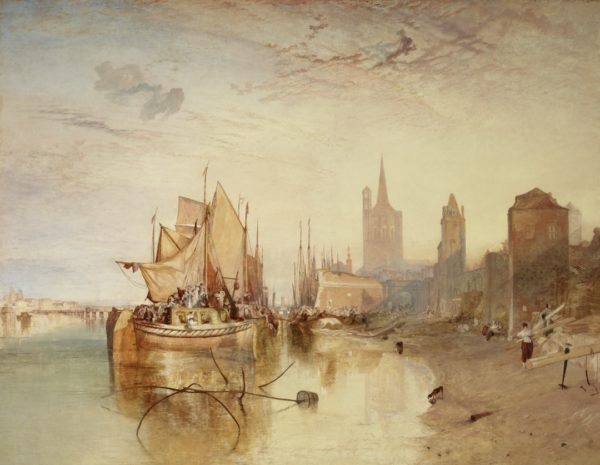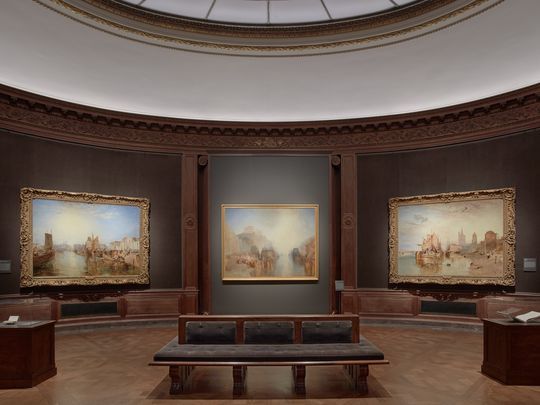
21 Apr TIO NYC: Big Show, Big Painter
Turner’s “Modern and Ancient Ports” at The Frick through May 14. “The Great Comet” is now up at The Imperial Theatre.
The two shows have little in common other than the timing, early 1800s, circa Napoleon. And both razzzle-dazzle – though very differently. One is hot and leads with knowing winks and hip thrusts; the other, luminous, advancing with a discerning eye and well-tempered brush. In the end, both are very buzzy events.

“The Great Comet” is a unique theatrical happening based on a 70-page slice of Tolstoy’s classic “War and Peace” adapted by show’s creator Dave Malloy.
For the uninitiated, the great Tolstoy novel chronicles the history of the French invasion of Russia by Napoleon and the impact of the Napoleonic era on Czarist history through the stories of five Russian aristocratic families.
“The Great Comet” evolved along those story lines as a pop opera. The production was originally commissioned and developed by Ars Nova, an adventurous Off-Broadway company, where it had its world premiere in 2012. Soon-after, in 2013, the show was transferred to a custom-built venue in the Meatpacking District. The latest incarnation of “Comet,” which we recently saw, transforms the Imperial Theatre, putting audience members in the middle of the action– in some cases (ours for example) on stage with the cast.
The action opens in 1812, just before Napoleon’s invasion of Russia. Natasha (lissome soprano Denée Benton) is a beautiful ingénue visiting Moscow where she waits for her fiancé Andrey (stalwart Nicholas Belton) to return from the war. However, in a moment of girlish indiscretion, she is seduced by the dashing (but married) Anatole (a deliciously smarmy Lucas Steele). Her position in society is ruined. Natasha’s only hope lies with Pierre (generally the show’s star, Josh Groban, but that night the role was performed by his understudy Scott Stangland, another golden tenor). Pierre is the lonely outsider whose love and compassion for Natasha may be the key to her redemption – and to the renewal of his otherwise wine-soaked soul.
“The Great Comet” is (yet another) hip spin on history taking Broadway by storm – the other of course being the much vaunted “Hamilton.” One major critic guardedly admitted to preferring “Comet,” sacrilege in some circles, but under the imaginative direction of Rachel Chavkin, up close and personal, the show is raucous fun – whether or not you come to care about what happens to these vapid, vacuous, vain creatures. (We didn’t). That said, the vibrant cast is nothing if not enthusiastic: all are blessed with great voices, very loose limbs, and expansive personalities. (As I said, especially the audience on stage, gets really cozy with the players.)
The walls of the Imperial are draped in red velvet and hung with gilt-framed paintings. Starburst chandeliers hang from the ceilings. We are in a drawing room, participants in the intrigue. Period-punk costumes add to the decadence on parade.
Something was definitely rotten in the city of Moscow.
Not so at the Frick Museum, where Turner now reigns supreme.
“Mr. Turner” was among the features at the 41st annual Telluride Film Festival. The plot of Mike Leigh’s biopic centers around the complicated life of the extraordinarily inventive, often irascible British Romantic painter J.M.W. Turner (1775-1851). And for many in the audience back then, the richly drawn movie, which felt like a documentary, was their first introduction to a wildly successful artist whose sometimes lyrical, sometimes furious landscapes and seascapes presaged modern movements such as Impressionism and Abstract Expressionism.
A show at LA’s Getty Museum in 2015 explored the artist’s late period, filled with proto-abstractions.
“Turner’s Modern and Ancient Ports” explores a turning point in the career of one of Britain’s greatest painters, the years 1810 – 1830. The show features a trio of port scenes, plus more than 30 oil paintings, watercolors, sketchbooks, and prints.

Central to the exhibition are those watercolors, often made to be turned into a series of prints for a bourgeoning class of leisure travelers in the post-Napoleonic era.
Turner was a man of his times, who espoused the notion first put forth by Baudelaire, that art mirrors, even anticipates, the zeitgeist. His career coincided with political, technological, and cultural developments that contrived to create a new context for ports. With Napoleon’s decisive defeat at Waterloo in 1815, a new era of tourism began and the enterprising artist meant to capitalize on a burgeoning market for the sights travelers had seen or hoped to see.
Representing port towns and cities along the various waterways of the British Isles and Continental Europe, these eye-popping, enchanting, small-scale works share with the grand harbors of the 1820s (in the adjacent room) picturesque subject matter and formal qualities of composition and color. The breathtaking effects of light and color Turner achieved in watercolor, in fact, informed his work on canvas, resulting in a freer approach to his use of materials and his painting technique.

What becomes clear all over again with this gem of show, is the fact Turner was a maverick – though he often confounded, even appalled his commentators and audiences. The artist’s use of light, color, and atmosphere, his swirling vortices of blinding energy, was unmatched in the 19th century (arguably beyond) for its bowl-you-over radiance and intensity.
GO!


Pingback:TIO NYC: “Vanity Fair,” Not Fair, Excellent | Telluride Inside... and Out
Posted at 10:15h, 22 April[…] TIO NYC: Big Show, Big Painter – April 21, 2017 […]